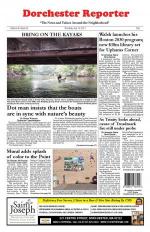November 15, 2012
Parents and residents gathered on Wednesday night at St. Katharine Drexel Church on Blue Hill Ave. to oppose proposed changes to the city's school assignment system. Those in attendance – many of whom were members of various community organizations – said each of the five models that have been proposed to replace the current 3-zone model would create “separate and unequal” schools.
The Coalition for Equal Quality Education, which hosted the community meeting, also argued that the proposed plans would reduce access to the highest performing schools for Roxbury, Dorchester and Mattapan students. A flyer promoting the meeting claimed the models under consideration by an advisory committee of parents and academics amount to “re-segregation.”
The coalition includes a few bus drivers unions, which would feel the impact of transportation cost savings from a move to neighborhood schools, as Mayor Thomas Menino has asked the advisory committee to consider.
With December 14 set as a potential target date for the advisory committee to offer a recommendation to Superintendent Carol Johnson, Barbara Fields, head of the Woodhaven area neighborhood association, said the timeline for proposals was so short that it was “set up to fail.” Fields said for the average person to review the proposals and give meaningful feedback was “pretty much impossible.”
Terrance Williams, a Boston Public Schools (BPS) parent, urged residents to pay attention to which politicians show up to these meetings “to see who really cares about the kids and their issues.”
The current assignment system uses 3 zones, in place for nearly 23 years. The formally proposed BPS plans include: 6 zones, 9 zones, 11 zones, 23 zones and a plan with no zones. But a computer-driven plan with no zones, put together by a Massachusetts Institute of Technology doctoral student, Peng Shi, has caught the eye of the committee. And on Tuesday night BPS presented various models based on his map and the 23-zone map.
A BPS analysis presented at the Tuesday night meeting of the advisory committee noted that 1 in 5 students have a less than 40 percent chance of access to a quality school, under the current 3-zone system. The problem is “most acute” in the East Zone, which includes Dorchester and Mattapan. The analysis also found the various proposals and models discussed increase access to a quality school for students.
As has been said at previous meetings, while BPS had different ways of measuring the quality of a school, parents have their own criteria for what constitutes a quality school. But what they could agree on was that, under the current system, quality was not consistent across the board.
LaRaye Myers-Thomas, office manager at Mothers for Justice and Equality, said, “The quality of the education that our children are receiving is not on an even level.”
Megan Wolf, a Jamaica Plain parent involved with QUEST (Quality Education for Every Student), agreed.
“Quality education is not quality in one neighborhood, it’s quality in all neighborhoods,” she said.
The meeting ended with shouts of “Fired up! Ready to go!” as well as a call to action. The CEQE is planning a demonstration at the Boston School Committee Meeting at 26 Court St. on Wednesday, December 19 at 5 pm and urged residents to come out and let the mayor and the committee know that they opposed the proposed models.
City Councillor At-Large John Connolly, joined by several elected officials, has put together his own model, which focuses on setting up several citywide “magnet” schools and eliminates school zones.



